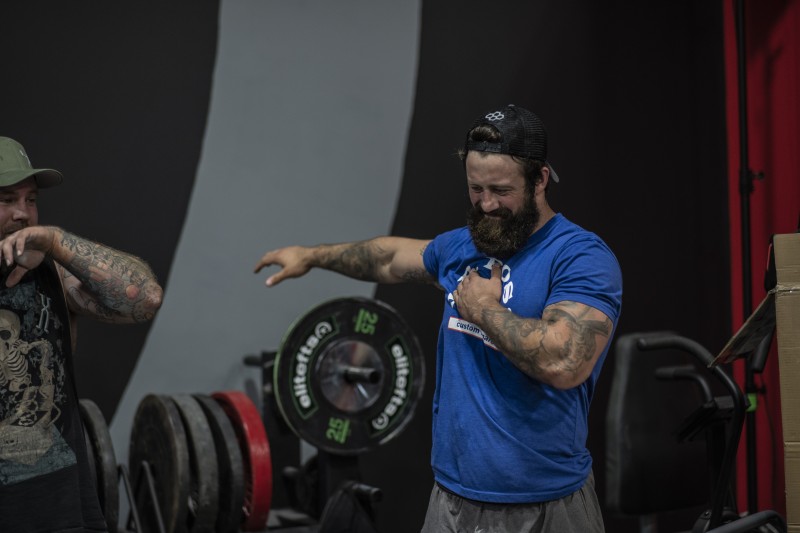
In my previous article, I discussed the unique considerations for lifters who work physically demanding jobs and what is important in order to be successful. Many of you asked about specific programming after reading the article, so that is what I’ll be outlining here. This won’t be one specific program, but rather, a step-by-step way to put a program together when working with the considerations discussed in the first article.
I phrase it as “put a program together,” but despite the title of this article, what I’m actually going to do is show you how to organize your training using pre-existing strength methods (which most programs are, anyways). The reason for this is that I’m going to assume that if you’re working a physically demanding job, the last thing you want to do is create a training program from scratch and spend hours contemplating exact percentages or waves. With the way I outline things here, you should be able to inventory your current situation, put together the program structure, and begin training quickly.
RECENT: How to Train While Working a Physical Job
It is important to re-iterate that my suggestions are all chosen based on my philosophy for what makes a successful training program. I think these things will resonate with many of you and help you be successful, but if there’s something here you don’t agree with and would rather do differently, that’s great, too. The goal of all my articles is to help people think and develop their own approach. That being said, I encourage you to try this approach and give it time to work. As a lifter with a physically demanding job, remember that you’re playing the long game here. Short-sighted goals will not suit you well. On that note…
Step 1: Determine your Goals
If you’re going to train effectively, you have to know what you’re training for. Sounds obvious, but you could ask a lot of lifters what their goals are, and they wouldn’t be able to give you a straight answer. Having set goals also provides you a barometer to measure how your training is going and something to help you re-focus your training when you start to veer off course.
For this, I suggest picking a primary and secondary goal. Even as broad goals, this is enough to at least provide you with a foundation to work from. Then you can add specific details to these if desired, such as a numeral measurement to shoot for and an exact timeline.
Goals Example
Primary Goal: Improve 1RM on Squat and Overhead Press
- Add 10 pounds to Squat and 5 pounds to Overhead Press over the next 3 months as a new lifter.
Secondary Goal: “Build upper back and rear delts to help off-set all the pushing and pressing I do at work.”
- Reduce daily shoulder aches and pains from a 6 out of 10 on the pain scale to about a 4 out of 10.
Step 2: Prioritize
In addition to goals, the other thing that will help you keep training focused is recognizing where training falls in your life priorities. And in order to that, you need to know what your priorities are. Take a few minutes and write down the things in life that mean the most to you and that you want to dedicate your time and effort to accordingly. For most, these are things like family, career, friendships, faith, training, relationship, a hobby, etc. Write out the top 5 and determine if training falls in that list, and if so, where. Recognizing this will help you make sure that your approach to training matches up with your priorities.
Top 5 Priorities Example
- Faith
- Family
- Career
- Training
- Relationship
Step 3: Inventory Your Work Demands
If you’re going to train effectively, you have to recognize how training can fit within the context of your job. This was a big emphasis of the first article of this series and is something you can’t ignore.
Jot down what the time, mental, and physical demands of your job are so you can better choose the components of your program.
Work Demands Example
- Time Demands: 55 hours per week on average (about 9 hours/day)
- Physical Demands: Consistent moderate lifting and carrying (50-100 pounds) throughout the entire day. Occasional heavy lifting (200+ pounds).
- Mental Demands: Stressful task management of multiple employees throughout the day. Still answering work phone calls after the day is over.
Step 4: Pick Training Frequency
Now that you’ve identified the context that training will fit into, you have to determine how many days a week is realistic and sustainable to train. This is one of the most important times to think practically and not idealistically. Based on your goals, where training rests as a priority for you, and your ability to recover based on the demands of your job, you will need to select how many days per week you want to train. For most people who work physically demanding jobs, two or three days per week tend to work best in my opinion. Make sure you take everything we’ve discussed so far into consideration (if training is listed below family in your priorities, spending more time at the gym than with your kids wouldn’t fit with your priority list).
Training Frequency Example
- 3 Days Per Week (Monday, Thursday, Saturday)
Step 5: Pick Primary Movements and Progression
Now based on your goals and training frequency, pick what primary strength movements you want your program to center around. These should be movements that align with your goals and are things you can do within your time constraints and physical ability (maybe deadlifting as a primary movement isn’t the best idea if you use your back to lift heavy things every day already).
You’ll also need to pick a progression/periodization for these lifts to follow. For the sake of simplicity, there are a couple options you could use. They each have their pros and cons, but again, we’re trying to keep this simple build consistency. No matter what you use, if it involves percentages, I recommend always using a training max of 85 to 90 percent of your actual max. Especially as someone under high physical demands, this will pay off, as your recovery fluctuates from day to day.
Option 1
Example of Basic Linear Progression (9 weeks then reset maxes) – I personally don’t use linear percent-based programs very often, but it is an option if you just simply need something to get you following a plan versus just going in and working out.
- Week 1: 3x15 @ 60%
- Week 2: 3x12 @ 65%
- Week 3: 3x10 @ 70%
- Week 4: 3x8 @ 75%
- Week 5: 3x6 @ 80%
- Week 6: 3x5 @ 85%
- Week 7: 3x3 @ 90%
- Week 8: 3x1 @ 95%
- Week 9: Work up to Single with 100+%
Option 2
Choose an existing program structure (such as 5/3/1) - I’ve always been a big proponent of Jim’s philosophies and his 5/3/1 program, and I think for lifters who have limited time, high work demands, and need to be efficient with their time in the gym, 5/3/1 is a great progression to use for your primary lifts. For the population reading this article, I think using a proven strength progression for your training is a wise decision and takes extra week-to-week thinking out of the equation. There are plenty of options for this, but I would recommend going with (1) simple and (2) proven.
Primary Movements and Progression Example
- Movement 1: Squat
- Movement 2: Overhead Press
- Progression: 5/3/1
Step 6: Pick Secondary Movements
These secondary (or supplemental) movements will help build the strength of the primary movements you chose, as well as address your secondary goals. Think of good bang-for-your-buck with these, that will give you a lot of return on one single movement. Large multi-joint barbell or dumbbell movements are good options for this.
In terms of progression for these, I like to use RPE (rating of perceived exertion) in order to remove strict percentages from the mix. These also allow for the ebb and flow of recovery and provide a good framework for making consistent progression. I recommend doing this in 3- to 4-week waves, with shorter waves the more advanced of a lifter you are.
4-Week Wave Example
- Week 1: Work up to set of 8 @ RPE of 7/10 (leaving 3 reps in the tank)
- Week 2: Work up to set of 8 @ RPE of 8/10 (leaving 2 reps in the tank – but beat previous week’s weight)
- Week 3: Work up to set of 5 @ RPE of 8/10 (leaving 2 reps in the tank)
- Week 4: Work up to set of 5 @ RPE of 9/10 (leaving 1 rep in the tank – but beat previous week’s weight)
*For all of these weeks, you would work up in sets of the same rep count as that day (so working up to a set of 8 with sets of 8). Start with an empty barbell and work up slowly, not jumping more than 10 percent of your max at a time once you hit about 60 percent.
Secondary Movements Example
- Movement 1: Safety Bar Pause Squat
- Movement 2: Incline Barbell Bench Press
- Movement 3: Trap Bar Deadlift
Step 7: Pick Assistance Movements
Finally, you’ll need to pick assistance movements to help support your goals, prevent injury, and fill in the gaps that may be left between your primary/secondary movements and your physical job. For your purposes, I recommend picking no more than two to three movements per training session to follow your secondary movements.
For progression, I would recommend keeping most movements to 2-4 sets of 8-15 reps, and perform them in 3- to 4-week waves as well. Don’t overthink these; make these quality movements and be consistent, as these will help offset and support the other work you do. Approach these more like a bodybuilder and focus on getting blood flow and good range-of-motion.
Assistance Movements Example
- Day 1: Machine Hamstring Curls, Ab Wheel
- Day 2: T-Bar Rows, Rear Delt Flyes, Dumbbell Bicep Curls
- Day 3: Leg Press, Band Pull-Aparts, Band Tricep Pushdowns
Program Sample
Here is an example of what the program could look like based on the examples I provided (again, these are just examples, yours will likely vary):
Day 1: Squat – 5/3/1
- SSB Pause Squat – RPE Progression
- Machine Hamstring Curls – 3x15
- Ab Wheel – 3x10
Day 2: Overhead Press – 5/3/1
- Incline Barbell Bench Press – RPE Progression
- T-Bar Rows – 3x8
- Rear Delt Flyes – 3x15
- Dumbbell Bicep Curls – 3x10
Day 3: Trap Bar Deadlift – RPE Progression
- Leg Press – 4x8
- Band Pull-Aparts – 3x15
- Band Tricep Pushdowns – 3x25
Once you go through these seven steps, you should have a nice simple program that will allow you to reach your goals while staying true to your priorities and meshing with your daily work demands. Individual articles could be written about each of these steps, but again, the purpose of this article is to provide a simple roadmap to get training. Have a plan, make it realistic, and be consistent and disciplined in your execution.
Header image credit: jpchret © 123rf.com












